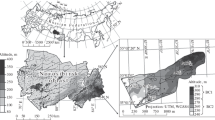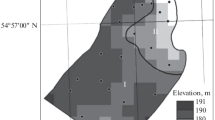Abstract
The informativeness of NDVI for predictive mapping of the physical and chemical properties of plow horizons of soils on different slope positions within the first (280–310 m a.s.l.) and second (240–280 m a.s.l.) altitudinal steps has been examined. This index is uninformative for mapping soil properties in small hollows, whose factual width is less than the Landsat image resolution (30 m). In regression models, NDVI index explains 52% of variance in the content of humus; 35 and 24% of variance in the contents of total and nitrate nitrogen; 19 and 29% of variance in the contents of total and available phosphorus; 25 and 50% of variance in the contents of exchangeable calcium and manganese; and 30 and 29% of variance in the contents of fine silt and soil water, respectively. On the basis of the models obtained, prognostic maps of the soil properties have been developed. Spatial distribution patterns of NDVI calculated from Landsat 8 images (30-m resolution) serve as the cartographic base and the main indicator of the soil properties. The NDVI values and the contents of humus, physical clay (<0.01 mm) and fine silt particles, total and nitrate nitrogen, total phosphorus, and exchangeable calcium and manganese in the soils of the first altitudinal step are higher than those in the soils of the second altitudinal step. An opposite tendency has been found for the available phosphorus content: in the soils of the second altitudinal step and the hollow, its content is higher than that in the soils of the first altitudinal step by 1.8 and 2.4 times, respectively. Differences in the pH of soil water suspensions, easily available phosphorus, and clay in the soils of the compared topographic positions (first and second altitudinal steps and the hollow) are statistically unreliable.
Similar content being viewed by others
References
Agrochemical Methods of Soil Studies (Nauka, Moscow, 1975) [in Russian].
V. N. Antonov and L. A. Sladkikh, “Monitoring of crops and prediction of the yield of winter wheat on the basis of remote sensing data,” Geomatika, No. 4 (5), 50–53 (2009).
V. N. Afanas’ev and A. P. Tsypin, Econometrics in STATISTICA Software: Manual for Laboratory Practicum (Orenburg State Univ., Orenburg, 2008) [in Russian].
N. V. Gopp, “Algorithm for compilation of digital soil maps based on field, laboratory, and satellite data,” Issled. Zemli Kosmosa, No. 3, 58–72 (2013).
N. V. Gopp, “Modeling of the reserves of aboveground phytomass of tundra communities using ground and satellite data,” Gorn. Inf.-Anal. Byull. 17 (12), 200–205 (2009).
N. V. Gopp, O. A. Savenkov, T. V. Nechaeva, and V. V. Smirnov, “Influence of morphometric parameters of the relief on spatial variability of the content of exchangeable potassium in a typical agrogray soil,” Agrokhimiya, No. 5, 54–63 (2014).
S. M. Davis, D. A. Landgrebe, T. L. Phillips, P. H. Swain, R. M. Hoffer, J. C. Lindenlaub, and L. F. Silva, Remote Sensing: The Quantitative Approach, Ed. by P. H. Swain and S. M. Davis (McGraw-Hill, New York, 1978; Nedra, Moscow, 1983).
A. J. Gerrard, Soils and Landforms: An Integration of Geomorphology and Pedology (Unwin Hyman, London, 1982; Nedra, Leningrad, 1984).
N. R. Draper and H. Smith, Applied Regression Analysis (Wiley, New York, 1981; Finansy i Statistika, Moscow, 1986).
P. Duchaufour, Précis de Pédologie, L'Évolution des Sols (Masson et Cie, Paris, 1965; Progress, Moscow, 1970).
T. I. Evdokimova, Soil Survey (Moscow State Univ., Moscow, 1987) [in Russian].
T. V. Zvonkova, Applied Geomorphology (Vysshaya Shkola, Moscow, 1970) [in Russian].
A Map of Agroindustrial Soil Groups and Recommendations for Their Use by Rassvet Collective Farm, Toguchinskii District, Novosibirsk Oblast, Scale 1: 25000 (Zapsibgiprozem, Novosibirsk, 1978) [in Russian].
A. N. Kashtanov and V. E. Yavtushenko, Agroecology of Soils on Slopes (Kolos, Moscow, 1997) [in Russian].
Classification and Diagnostics of Soils of the Soviet Union (Kolos, Moscow}, 1977) [in Russian]
L. L. Shishov, V. D. Tonkonogov, I. I. Lebedeva, and M. I. Gerasimova, Classification and Diagnostic System of Russian Soils (Oikumena, Smolensk, 2004) [in Russian].
O. A. Luchitskaya and V. N. Bashkin, “Influence of relief on soil fertility,” Agrokhimiya, No. 5, 109–114 (1995).
Methodology of Multiple Monitoring of Agricultural Land Fertility (Rosinformagrotekh, Moscow, 2003) [in Russian].
V. M. Nazaryuk, O. A. Savenkov, and N. V. Smirnova, “Substantiation and analysis of the fertility parameters of soils and plant productivity for the modeling of nitrogen cycle in agroecosystems,” Sib. Ekol. Zh. 11 (3), 391–401 (2004).
A. D. Orlov, Erosion and Erosion-Prone Lands in Western Siberia (Nauka, Novosibirsk, 1983) [in Russian].
Field Guide for Correlation of Russian Soils (Dokuchaev Soil Science Institute, Moscow, 2008) [in Russian].
Soil-Agrochemical Problems of Agricultural Intensification in Siberia (Siberian Scientific Research Institute of Agriculture, Novosibirsk, 1989) [in Russian].
I. Yu. Savin, E. R. Tanov, and S. Kharzinov, “Use of vegetation index NDVI for evaluation of arable soil quality in Baksan district (Kabardino-Balkaria Republic),” Byull. Pochv. Inst. im. V.V. Dokuchaeva, No. 77, 51–65 (2015).
A. S. Cherepanov, “Vegetation indices,” Geomatika, No. 2, 98–102 (2011).
Econometrics: Methodological Guidelines on the Study Course and on Practical Works using Computer (Vuzovskii Uchebnik, Moscow, 2005) [in Russian].
V. E. Yavtushenko and N. B. Makarov, “Losses of organic matter and nutrients as the result of water erosion,” Agrokhimiya, No. 4, 117–123 (1996).
O. P. Yakutina, T. V. Nechaeva, and N. V. Smirnova, “Regime of major nutrients and plant productivity on eroded soils in the south of Western Siberia,” Probl. Agrokhim. Ekol., No. 1, 16–22 (2011).
C. Ballabio, F. Fava, and A. Rosenmund, “A plant ecology approach to digital soil mapping, improving the prediction of soil organic carbon content in alpine grasslands,” Geoderma 1, 102–116 (2012).
N. V. Gopp, “Soils of the southwestern part of the Dzhulukul Depression in the Altai Republic,” Eurasian Soil Sci. 48, 567–577 (2015).
P. J. Curran, “Multispectral remote sensing of vegetation amount,” Progr. Phys. Geogr. 4, 315–341 (1980).
A. R. Huete and H. Q. Liu, “An error and sensitivity analysis of the atmospheric-and soil-correcting variants of the NDVI for the MODIS-EOS,” IEEE Trans. Geosci. Remote Sens. 32, 897–905 (1994).
IUSS Working Group WRB, World Reference Base for Soil Resources, International Soil Classification System for Naming Soils and Creating Legends for Soil Maps, World Soil Resources Reports No. 106 (Food and Agriculture Organization, Rome, 2014).
P. Kumar, P. C. Pandey, B. K. Singh, S. Katiyar, V. P. Mandal, M. Rani, V. Tomarf, and S. Patairiya, “Estimation of accumulated soil organic carbon stock in tropical forest using geospatial strategy,” Egypt. J. Remote Sens. Space Sci. 19, 109–123 (2016).
S. Lamsal, S. Grunwald, G. L. Bruland, C. M. Bliss, and N. B. Comerford, “Regional hybrid geospatial modeling of soil nitrate–nitrogen in the Santa Fe River watershed,” Geoderma 135, 233–247 (2006).
H. Laurila, M. Karjalainen, J. Kleemola, and J. Hyyppä, “Cereal yield modeling in Finland using optical and radar remote sensing,” Remote Sens. 2, 2185–2239 (2010).
D. F. Lozano-Garcia, R. N. Fernandez, and C. J. Johannsen, “Assessment of regional biomass-soil relationships using vegetation indexes,” IEEE Trans. Geosci. Remote Sens. 29 (2), 331–339 (1991).
N. J. McKenzie and P. J. Ryan, “Spatial prediction of soil properties using environmental correlation,” Geoderma 89, 67–94 (1999).
A. Mondal, D. Khare, S. Kundu, S. Mondal, S. Mukherjee, and A. Mukhopadhyay, “Spatial soil organic carbon (SOC) prediction by regression kriging using remote sensing data,” Egypt. J. Remote Sens. Space Sci., (2016). http://dx.doi.org/ doi 10.1016/ j.ejrs.2016.06.004
Precision Agriculture, Ed. by J. V. Stafford (Wageningen Akademic, Wageningen, 2005).
R. G. Rivero, S. Grunwald, S. Newman, T. Z. Osborne, and K. R. Reddy, “Incorporation of ASTER satellite imagery into multivariate geostatistical models to predict soil phosphorus,” Biannual Meeting of Commission 1.5 Pedometrics (International Union of Soil Science Naples, Fl, 2005), pp. 75–76.
J. W. Rouse, R. H. Haas, J. A. Schell, and D. W. Deering, “Monitoring vegetation systems in the Great Plains with ERTS,” Third Earth Resources Technology Satellite-1 Symposium, NASA SP-351 I (Washington, 1973), 309–317.
P. A. Shary, L. S. Sharaya, and A. V. Mitusov, “Fundamental quantitative methods of land surface analysis,” Geoderma 107 (1–2), 1–32 (2002).
K. Sumfleth and R. Duttmann, “Prediction of soil property distribution in paddy soil landscapes using terrain data and satellite information as indicators,” Ecol. Indic. 8 (5), 485–501 (2008). http://dx.doi.org/. doi 10.1016/j.ecolind.2007.05.005
O. P. Yakutina, T. V. Nechaeva, and N. V. Smirnova, “Consequences of snowmelt erosion: soil fertility, productivity, and quality of wheat on greyzemic phaeozem in the south of West Siberia,” Agric., Ecosyst. Environ. 200, 88–93 (2015).
Author information
Authors and Affiliations
Corresponding author
Additional information
Original Russian Text © N.V. Gopp, T.V. Nechaeva, O.A. Savenkov, N.V. Smirnova, V.V. Smirnov, 2017, published in Pochvovedenie, 2017, No. 11, pp. 1377–1389.
Rights and permissions
About this article
Cite this article
Gopp, N.V., Nechaeva, T.V., Savenkov, O.A. et al. Indicative capacity of NDVI in predictive mapping of the properties of plow horizons of soils on slopes in the south of Western Siberia. Eurasian Soil Sc. 50, 1332–1343 (2017). https://doi.org/10.1134/S1064229317110060
Received:
Published:
Issue Date:
DOI: https://doi.org/10.1134/S1064229317110060




